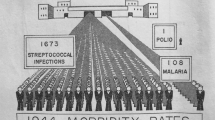Abstract
Biological warfare is intended to incapacitate a large number of individuals at a single exposure, creating epidemictype disease, death, and social chaos. The organisms with potential for immediate use as bacteriologic weapons are Bacillus anthracis, Brucella melitensis, Yersinia pestis, and Vibrio cholera, all necessitating antibiotic therapy for a cure. It is reasonable, therefore, to assume that a biological attack, or even a hoax, would requiure thousands of individuals over a large area to begin antibiotic therapy. Issues such as antibiotic availability, logistical problems in antibiotic distribution, development of drug resistance, side effects influencing the individual, and adverse effects on the community due to the impact of mass therapy on the ecology, make biological warfare the most apocalyptic scenario for the creation of a "postantibiotic era."
Similar content being viewed by others
References and Recommended Reading
Robertson AG, Robertson LJ: From asps to allegations: biological warfare in history. Mil Med 1995, 160:369–373.
Christopher GW, Cieslak TJ, Paulin JA, Eitzen EM: Biological earfare: s historical perspective. JAMA 1997, 278:412–417.
Manchee RJ, Stewart R: The decontamination of Gruinard Island. Chem Br 1988, 24:690–691.
Mackawa K: The Sarin incident in Tokyo subways. In Proceedings of the 5th International Symposium on Protection against Chemical and Biological Warfare Agents. Stockholm; 1995:31–37.
Chemical and biological weapons: the hazard to health. WHO Chron 1970, 24:99–108.
Kauffmann AF, Meltzer MI, Schmid GP: The economic impact of a bio-terrorist attacks - are prevention and post attack intervention programs justifiable? Emerg Infect Dis 1997, 3:83–94.
Guillemin: Anthrax: The Investigation of a Deadly Outbreak. Berkley: University of California Press; 1999.
Tucker JB: Historical trends related to bio-terrorism: an empirical analysis. Emerg Infect Dis 1999, 5:498–504.
Khan AS, Ashford DA: Ready or not-preparedness for bioterrorism. N Engl J Med 2001, 345:287–289. An editorial stating that the main obstacle for domestic preparedness is inadequate public-service infrastructure. This was a major lesson learned from a $3 million drill that tested the readiness of top government officials for a terrorist attack, which included a 3-day exercise involving the release of plague in Denver.
Inglesby TV, Henderson DA, Bartlett JG, et al.: Anthrax as a biological weapon. JAMA 1999, 281:1735–1745. An important statement on diagnosis of anthrax, indications for vaccination, therapy of exposed subjects, postexposure prophylaxis, decontamination of the environment, and research needs issued by a working group that included 21 representatives of major academic centers, government, military, public health, and emergency management institutions in the United States.
Friedlander AM, Welkes SL, Pitt LML, et al.: Post-exposure prophylaxis against experimental inhalation anthrax. J Infect Dis 1993, 167:1239–1292.
Kelly DJ, Chulay JD, Mikesell P, Friedlander AM: Serum concentrations of penicillin, doxycycline and ciprofloxacin during prolonged therapy in Rhesis monkeys. J Infect Dis 1992, 161:1184–1187.
Inglesby TV, Dennis DT, Henderson DA, et al.: Plague as a biological weapon. JAMA 2000, 28b:2281–2290. The Working Group on Civilian Biodefense comprising 25 representatives from major academic medical centers and research, government, military, public health, and emergency management institutions and agencies, has developed recommendations to be used by medical and public health professionals following the use of plague as a biological weapon against a civilian population. For early therapy and prophylaxis, streptomycin, gentamicin, or an agent from the tetracycline or fluoroquinolone families can be used.
Inglesby TV: Anthrax: a possible case history. Emerg Infect Dis 1999, 5:556–560.
Doganay M, Aydun N: Antimicrobial susceptiblity of Bacillus anthracis. Scand J Infect Dis 1991, 23:333–335.
Odendaal MW, Peterson PM, de Vos V, Bohka AD: The antibiotic sensitivity pattern of Bacillus anthracis isolated from the Kruger National Park. J Vet Res 1991, 58:17–19.
Stefanov AV, Merinin LI, Romerantsev AP, Staritsin NA: Development of novel vaccines against anthrax in man. J Biotechnol 1996, 44:155–160.
Choe CH, Bouhaoula SS, Brook I, et al.: In vitro development of resistance to ofloxacin and doxycyline in Bacillus anthracis Sterne. Antimicrob Agents Chemother 2000, 44:1766.
Committee on Infectious Diseases: Plague. In 1997 Redbook. Edited by Peter G. Elk Grove Village, IL: American Academy of Pediatrics; 1997:408–410.
Galimand M, Guigoule A, Gerband G, et al.: Multidrug resistance in Yersinia pestis mediated by a transferrable plasmid. N Engl J Med 1997, 337:677–681.
Smith MD, Vin HDX, Hoa NT, et al.: In vitro antimicrobial susceptibilites of strain of Y. pestis. Antimicrob Agents Chemother 1995, 39:2153–2154.
Russell P, Eleg SM, Bell DL, et al.: Doxycycline and ciprofloxacin prophylaxis and therapy against experimental Y. pestis infection in mice. J Antimicrob Chemother 1996, 37:769–779.
Byrne WR, Welkos SL, Pitt MC, et al.: Antibiotic treatment of experimental pneumonic plague in mice. Antimicrob Agents Chemother 1998, 42:675–681.
Ryznnko IV, Shcherbaniuk AI, Samokhodkim ED, et al.: Virulence of rifampin and quinolone resistant mutants of strains of plague microbe with Fra+ and Fra - phenotypes. Antibiot Khumioter 1994, 39:32–36.
Ailbek K, Handelman S: Biohazard. New York: Random House; 1999.
Guiogoule A, Gerbaud G, Buchrusen C, et al.: Transferable plasmid mediated resistance to streptomycin in a clinical isolate Yersinia pestis. Emerg Infect Dis 2001, 7:43–48.
Joshi N, Miller DQ: Doxycycline revisited. Arch Intern Med 1997, 157:1422–1428.
Austin DJ, Kristinsson KG, Anderson RM: The relationship between the volume of antimicrobial consumption in human communities and the frequency of resistance. Proc Natl Acad Sci U S A 1999, 96:1152–1156.
Author information
Authors and Affiliations
Rights and permissions
About this article
Cite this article
Rubinstein, E., Levi, I. Biological warfare: Implications for antimicrobial use. Curr Infect Dis Rep 4, 28–34 (2002). https://doi.org/10.1007/s11908-002-0064-5
Issue Date:
DOI: https://doi.org/10.1007/s11908-002-0064-5




